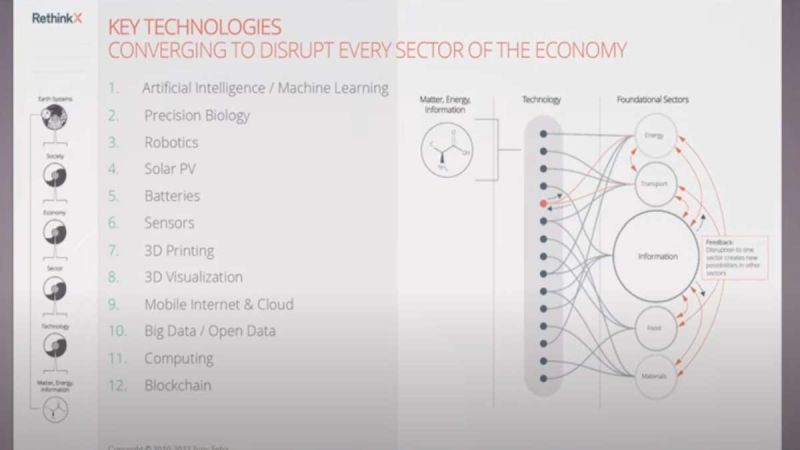Tesla and the Exponential Adoption of EVs
There are a number of key technologies converging here in the 2020's that will be beneficial because Tesla is involved in the majority of them. They are energy, transport, information, food, and materials.
These are big disruptions and Tesla is even getting involved with food at a small level with cafes being built. There are 5 key areas of this technological disruption:
1: How Disruption Really Works
The electricity grid has been around for about 100 years. There have been a variety of electricity generation technologies, but there has been no change to the grid to compensate for this.
Tesla is in a position to disrupt the electrical grid with virtual power plants as a distributed utility and the ability for others to make money while sending money back into the grid.
All technologies, like batteries, solar panels, and computers are improving at a predictable rate. These are the 3 primary divisions of Tesla as a company. Tesla was on the right path with energy, batteries, and electric vehicles to be a disruption.
2: Disruption of Transportation
There is a disruption of transportation happening due to the exponential growth of batteries, energy, and computers. Tesla's vehicles are fully electric and have been built since 2010. Over that time, there have been improvements in battery technology and manufacturing processes from Tesla.
The cost curve of Lithium-Ion batteries is continuing to go down. There are also these areas with continuing cost declines and improvements:
* Computing power (Moore's Law)
* Data storage (Kryder's Law)
* Digital imaging (Hendy's Law)
* Network capacity (Butter's Law of Photonics)
* Touchscreen, batteries, sensors, GPS, etc...
3: Disruption of Energy
As batteries continue to improve and have more storage in a smaller space, they will continue to flood the earth as the means to store energy and power electric vehicles.
For instance, the Model 3 RWD I recently bought, has about 272 miles of range with an LFP battery that should last half a million miles.
A Tesla Model S from 2016 can be purchased used for just a little bit more than my Model 3 and with 85,000 miles, with a 253 mile range using a Lithium-Ion battery that shouldn't be charged to 100% as often as my Model 3 can.
Tesla continues to improve the range of its vehicles. I have no doubt in 10 years that there will be a Model 3 RWD vehicle of some sort getting about 350 to 400 miles of range. That may be a good time for me to replace my battery if I've driven my vehicle a lot.
4: Disruption of Food and Agriculture
Tesla most likely won't be involved in this category, but other companies will be.
5: Implications: Climate Change, Land Use, and Economy
There are many ways in which Tesla is addressing the issues here: Tesla is addressing climate change with EVs and clean energy with batteries and solar storage.
They are also addressing the economy with the ability for one to eventually make money renting their vehicle out as a robotaxi, and allowing others to have a virtual power plant to send energy back into the grid.
What do you think about Tesla - are they a truly disruptive company?
For more information, see this video by Steven Mark Ryan:
Leave your comments below, share the article with friends and tweet it out to your followers.
Jeremy Johnson is a Tesla investor and supporter. He first invested in Tesla in 2017 after years of following Elon Musk and admiring his work ethic and intelligence. Since then, he's become a Tesla bull, covering anything about Tesla he can find, while also dabbling in other electric vehicle companies. Jeremy covers Tesla developments at Torque News. You can follow him on Twitter or LinkedIn to stay in touch and follow his Tesla news coverage on Torque News.











